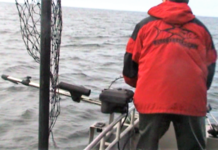
Hurricane Sandy as seen from NOAA’s GOES-13 satellite on October 28, 2012. Image courtesy of NOAA/NASA.
In the Atlantic and Northeast Pacific, we use the term “hurricane” to describe severe storms with high-velocity winds that rotate around a central, low-pressure core. The same type of disturbance in the Northwest Pacific is called a “typhoon” and “cyclones” occur in the South Pacific and Indian Ocean.
In order for a hurricane to form, two things must be present: a weather disturbance, such as a thunderstorm, that pulls in warm surface air from all directions and water at the ocean’s surface that is at least 80° Fahrenheit (27° Celsius). Because it is the interaction of warm air and warm seawater that spawns these storms, they form over tropical oceans between about 5 and 20 degrees of latitude. At these latitudes, seawater is hot enough to give the storms strength and the rotation of the Earth makes them spin.
Hurricanes start simply with the evaporation of warm seawater, which pumps water into the lower atmosphere. This humid air is then dragged aloft when converging winds collide and turn upwards. At higher altitudes, water vapor starts to condense into clouds and rain, releasing heat that warms the surrounding air, causing it to rise as well. As the air far above the sea rushes upward, even more warm moist air spirals in from along the surface to replace it.
As long as the base of this weather system remains over warm water and its top is not sheared apart by high-altitude winds, it will strengthen and grow. More and more heat and water will be pumped into the air. The pressure at its core will drop further and further, sucking in wind at ever increasing speeds. Over several hours to days, the storm will intensify, finally reaching hurricane status when the winds that swirl around it reach sustained speeds of 74 miles per hour or more.
Eventually, hurricanes turn away from the tropics and into mid-latitudes. Once they move over cold water or over land and lose touch with the hot water that powers them, these storms weaken and break apart.
Recent studies have shown a link between ocean surface temperatures and tropical storm intensity – warmer waters fuel more energetic storms.
For More Information:
Hurricanes, Multimedia Discovery Missions
Hurricanes, NOAA Educational Resources
Sign up for the Ocean Explorer E-mail Update List.














